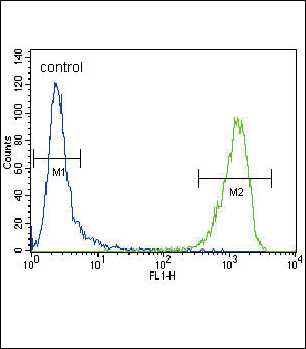ACTA1/Alpha-actin Antibody (C-term)
Affinity Purified Rabbit Polyclonal Antibody (Pab)
- SPECIFICATION
- CITATIONS: 2
- PROTOCOLS
- BACKGROUND

Application
| WB, IHC-P, IF, FC, E |
|---|---|
| Primary Accession | P68133 |
| Other Accession | P68136, P68135, P68137, P68134, P68139, P68138, P04751, P68035, P68033, P68032, P68034, Q3ZC07, P62738, P62740, P62737, P62736, P08023, P62739, P04752, P10995, NP_001091.1 |
| Reactivity | Human |
| Predicted | Xenopus, Bovine, Chicken, Mouse, Rabbit, Rat, Pig |
| Host | Rabbit |
| Clonality | Polyclonal |
| Isotype | Rabbit IgG |
| Calculated MW | 42051 Da |
| Antigen Region | 346-375 aa |
| Gene ID | 58 |
|---|---|
| Other Names | Actin, alpha skeletal muscle, Alpha-actin-1, ACTA1, ACTA |
| Target/Specificity | This ACTA1/Alpha-actin antibody is generated from rabbits immunized with a KLH conjugated synthetic peptide between 346-375 amino acids from the C-terminal region of human ACTA1/Alpha-actin. |
| Dilution | WB~~1:1000 IHC-P~~1:10~50 IF~~1:10~50 FC~~1:10~50 E~~Use at an assay dependent concentration. |
| Format | Purified polyclonal antibody supplied in PBS with 0.09% (W/V) sodium azide. This antibody is purified through a protein A column, followed by peptide affinity purification. |
| Storage | Maintain refrigerated at 2-8°C for up to 2 weeks. For long term storage store at -20°C in small aliquots to prevent freeze-thaw cycles. |
| Precautions | ACTA1/Alpha-actin Antibody (C-term) is for research use only and not for use in diagnostic or therapeutic procedures. |
| Name | ACTA1 |
|---|---|
| Synonyms | ACTA |
| Function | Actins are highly conserved proteins that are involved in various types of cell motility and are ubiquitously expressed in all eukaryotic cells. |
| Cellular Location | Cytoplasm, cytoskeleton. |

Provided below are standard protocols that you may find useful for product applications.
Background
The product encoded by this gene belongs to the actin family of proteins, which are highly conserved proteins that play a role in cell motility, structure and integrity. Alpha, beta and gamma actin isoforms have been identified, with alpha actins being a major constituent of the contractile apparatus, while beta and gamma actins are involved in the regulation of cell motility. This actin is an alpha actin that is found in skeletal muscle. Mutations in this gene cause nemaline myopathy type 3, congenital myopathy with excess of thin myofilaments, congenital myopathy with cores, and congenital myopathy with fiber-type disproportion, diseases that lead to muscle fiber defects.
References
Kim, E.Y., et al. Am. J. Physiol. Renal Physiol. 299 (3), F594-F604 (2010) :
Haigh, S.E., et al. Neuromuscul. Disord. 20(6):363-374(2010)
Yu, G., et al. J Clin Neurosci 17(6):766-769(2010)
Yu, C.H., et al. PLoS ONE 5 (7), E11878 (2010) :
Licastro, F., et al. Curr. Pharm. Des. 16(7):783-788(2010)
If you have used an Abcepta product and would like to share how it has performed, please click on the "Submit Review" button and provide the requested information. Our staff will examine and post your review and contact you if needed.
If you have any additional inquiries please email technical services at tech@abcepta.com.














 Foundational characteristics of cancer include proliferation, angiogenesis, migration, evasion of apoptosis, and cellular immortality. Find key markers for these cellular processes and antibodies to detect them.
Foundational characteristics of cancer include proliferation, angiogenesis, migration, evasion of apoptosis, and cellular immortality. Find key markers for these cellular processes and antibodies to detect them. The SUMOplot™ Analysis Program predicts and scores sumoylation sites in your protein. SUMOylation is a post-translational modification involved in various cellular processes, such as nuclear-cytosolic transport, transcriptional regulation, apoptosis, protein stability, response to stress, and progression through the cell cycle.
The SUMOplot™ Analysis Program predicts and scores sumoylation sites in your protein. SUMOylation is a post-translational modification involved in various cellular processes, such as nuclear-cytosolic transport, transcriptional regulation, apoptosis, protein stability, response to stress, and progression through the cell cycle. The Autophagy Receptor Motif Plotter predicts and scores autophagy receptor binding sites in your protein. Identifying proteins connected to this pathway is critical to understanding the role of autophagy in physiological as well as pathological processes such as development, differentiation, neurodegenerative diseases, stress, infection, and cancer.
The Autophagy Receptor Motif Plotter predicts and scores autophagy receptor binding sites in your protein. Identifying proteins connected to this pathway is critical to understanding the role of autophagy in physiological as well as pathological processes such as development, differentiation, neurodegenerative diseases, stress, infection, and cancer.




